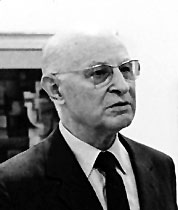
He was born on October 1st 1892 in La Plata in the Province of Buenos Aires. He studied at the Escuela de Bellas Artes in his native city and practised drawing when visiting the Natural History Museum. After taking a course in perspective, he began to exhibit his first works in the show windows of Gath & Chaves department store and to publish them in magazines - La Ciudad and Rayos de Sol. In June 1911, he held his first exhibition at the premises of the local daily paper Buenos Aires, which no longer exists.
In 1913, he travelled to Florence where he frequented the futurist avant-garde that, at that time, was holding its first Esposizione d'Arte Futurista "Lacerba". Pettoruti expressed his own idea of the dynamics of things in movement in his Armonía (Harmonies) series. In Italy, he took part in numerous exhibitions and visited several cities, studying different artistic techniques. Between 1916 and 1917 he lived in Rome where he became friends with the artists of the avant-garde circle gathered around Cronache d'Attualitá and Valori Pastici magazines, among them Giacomo Balla, Enrico Prampolini, Giorgio De Chirico, Carlo Carrá and others, who attended the encounters at the Aragno and Il Greco cafés. Then he settled down in Milan, where he was admitted to the Famiglia Artistica as socio pittore. At that time, he earned his living by illustrating books, designing stained-glass windows and planning theatre sets.
In 1920, he exhibited a synthetic landscape at the XII Biennale Internazionale in Venice. The following year, while participating in the Prima Mostra del Paesaggio Italiano and in the Esposizione Nazionale della Citta di Roma, the work he sent to be exhibited at the Salón Nacional was paradoxically rejected. Then, during his trip to Vienna and several German cities, exhibited in the Der Sturm Gallery in Berlin with great success. In 1924, Filippo Marinetti introduced him to Léonce Rosenberg who offered to be his art dealer and advised him against the show he was planning to put on in Argentina. Indeed, the works Pettoruti showed that year at Galería Witcomb in Buenos Aires gave rise to a heated discussion and opened the way for artistic language renovation.
He ran the Museo Provincial de Bellas Artes in La Plata between 1927 and January 1932. This year he was laid off his position, to which he would be restored a few months later. He exhibited at the Círculo de Bellas Artes, Montevideo (1939); Amigos del Arte, Buenos Aires (1940); the Museum of Art of San Francisco (1944) and at the National Academy in New York (1944). In 1947, he was again dismissed from his position as administrator of the Provincial Museum.
He returned to Europe, where he exhibited at Il Milione, Milan (1952); Numero, Florence (1952), and San Marco, Rome (1953) art galleries. He settled in Paris and exhibited at Durand-Ruel Gallery (1954); in Abstract Art, First Generations 1910-1939, at the Musée d'Art of Saint Etienne (1957); in 50 Years of Abstract Painting, organised by Michel Seuphor, and in other individual shows which approached his work to the people of that city. Since 1959 onwards, he participated in the Salon des Réalités Nouvelles. In 1960, he took part in the Primera Exposiciòn Internacional de Arte Moderno held at the Museo de Arte Moderno in Buenos Aires and also in Construction and Geometry in Painting, exhibition held in New York. In 1961, he exhibited in International Constructive Abstract Art, exhibition held at Galerie Denise René in Paris together with the most important international abstract artists.
In 1966, he travelled to Argentina and concluded his memoirs, published under the title Un pintor ante el espejo. He received the Guggenheim Continent of the Americas Prize (1956) and the Grand Prix awarded by the Fondo Nacional de las Artes (1967). In his last years, he exhibited in Bonn, Berlin, Brussels and Geneva, among other European cities, and represented Argentina in the XI São Paulo International Biennial in Brazil (1971). He died in Paris on October 16 th. 1971, at the age of 79.